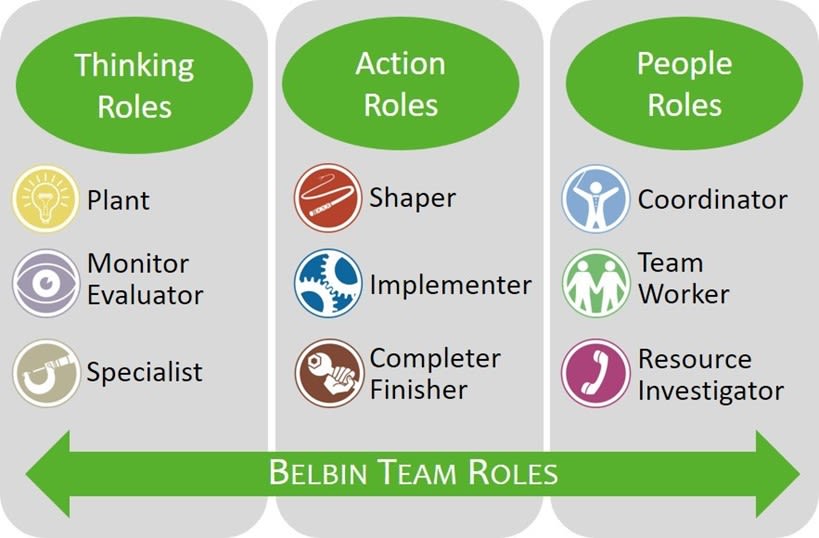Team Roles
Experiential Education

Introduction
Working in teams is a highly effective way of collaborating to organise people and identify, prioritise and complete tasks that can result in achieving desirable outcomes. If we draw on the skills and expertise of everyone rather than relying on one individual, the chances of achieving those outcomes is higher (Kozlowski & Ilgen 2006; Scarnati 2001). Learning about team tasks and what roles we are best suited to, as well as how teams work most effectively; can improve our team performance and lead to successful business or organisational outcomes (Deering 2021).
This module therefore introduces some key concepts and ideas on teamwork, but with a particular focus on team roles.
Objectives
What you will learn:
- The difference between a task and a role
- The roles people play in teams
- Belbin's Theory on Team Roles
Note: If you have not already completed the module on Group Development, which explores key stages for working in teams based on a well-known model by Dr Bruce Tuckman (1965), please do so before continuing on with Team Roles. This may help you to better understand some of the concepts in this module.

Team tasks and roles
What is the difference between a group task and a group role?
A role refers to the particular behaviour or functions that a team member undertakes as they participate within the group.
A task is what the group has been asked to do, or achieve, and should be clearly defined during the first meeting, which is typically part of the forming stage of the group’s development.

Team tasks
It is important to ensure team members know what is expected of them – particularly around outputs and tasks. A recommended way of doing this, is to start by asking the following questions:
- In the end – what do you need to do, achieve and/or produce? In other words, what are all of the outputs expected of the team? (we suggest you name up what the team is expected to achieve overall – the final output, then each individual task within that).
- What format will the final output be in? What will it look like?
- How will the team present what has been achieved or produced?
- When does the final output need to be completed by? That is, what is the final deadline?
- When does each task need to be completed by (to ensure the final deadline is met)?
- Who will complete each task?
Ideally, tasks should be allocated based on an individual’s strengths, expertise and ability to complete what is required – and team members may need to complete more than one task.
During the early stages of planning with the team, we suggest an open and honest discussion about skills and how each member can contribute to the success of the group. To do this, each team member can simply name up tasks they feel they have the expertise or ability to fulfil. For example, one team member may say:
- ‘I am good at finding reliable resources and information…’
- ‘I speak clearly and confidently and I am comfortable to do presentations…’
- ‘I am confident using different presentation software and technology…’
- ‘I often come up with new and creative ideas, especially through brainstorming with others…’
- ‘I am good at writing reports…’
- ‘I know how to analyse data and create visual representations of the results…’
From there, other team members can share their own strengths and abilities. This way everyone learns each other’s capabilities, which can then be drawn on to achieve the goals and meet expectations. Keep in mind, however, that sometimes it is necessary to work outside our comfort zone by doing tasks we may not be confident in, but this is part of our growth as team members.
Group work can be collaborative and cooperative and there are many benefits but it can also be challenging. If you actively work on your interpersonal and collaboration skills, and take a formal approach to managing the tasks and interactions within your group, you are likely to have a greater chance of success.
Why is it important to know the preferences of the team?
In this section we have explored the idea of individual team members discussing their own strengths, and taking on roles accordingly - so everyone can work together to meet desirable outcomes.
Some of the benefits of knowing the team role preferences include:
- Increased self-awareness and understanding of the strengths of others.
- Improved teamwork and communication skills.
- Greater confidence in team members.
- Improved interview skills.
(Leadership Solutions 2022a)

Team roles
Knowing how teams work and the roles people play when working together assists with the management and productivity of how milestones, targets and deadlines are met. Understanding how groups develop and move through key stages can also result in becoming a high energy and functional team (which is detailed more in the module on Group Development).
Possibly the most widely drawn on theorist when it comes to teamwork and team roles is Dr Meredith Belbin. Belbin (1999) defines a team in the following way:
‘A team is not a bunch of people with job titles, but a congregation of individuals, each of whom has a role which is understood by other members. Members of a team seek out certain roles and they perform most effectively in the ones that are most natural to them.’
So, every individual within a team must have a role and know what everyone else’s roles are. But, what is a team role?
According to Belbin (1999):
‘A team role is a tendency to behave, contribute and interrelate with others in a particular way.’
When defined in this way, roles are about behaviours and interactions.
In the following section we examine in greater detail the work of Dr Meredith Belbin (1999) – because it allows us to consider who we are and where we may be able to contribute the most - when working with others.

Belbin's theory on team roles
One of the most popular theories on team roles has been derived from Dr Meredith Belbin’s research and observations. Belbin’s findings are based on team work studies conducted over many years. Belbin famously observed that people in teams tend to assume different team roles. During this research, Belbin discovered that the underlying theory behind what makes a team successful lies in enabling an individual or team the benefit of self-knowledge and being flexible in accordance to the demands being made by the external situation (Harlty & Dawson, 2010 p. 52).
The underlying concept of Belbin’s Team Roles model is that it is a tool to measure behaviour, not personality. Moreover it is about understanding your behaviour strengths and weaknesses and consequently using them accordingly to best effect within the team you are working in to achieve set goals.
3 categories for Belbin’s 9 team roles
Belbin's Theory is based on nine team roles, categorised into three groups:
- Action Oriented Roles
- Thinking Oriented Roles
- People Oriented Roles
According to Belbin, people within groups can have many different roles and the roles may specifically depend on the group size and purpose. The image below highlights the 3 categories and lists the nine team roles underneath each (3 roles per category).

(Smartt Strategies 2019)
(Smartt Strategies 2019)
What are the 9 Team Roles?
Within the three categories, Belbin identified nine different behaviours (or contributions) that individuals display in the work place. These are referred to as the Belbin Team Roles. The key to working in a successful team is having the right mix of people to ensure all nine of the Team Role behaviours are represented.
However, this does not mean that teams should be specifically made up of nine team members. More importantly, it is a reminder that people in teams may have to take on more than one team role in the lifespan of the group. Each of the nine team roles are associated with typical behavioural and interpersonal strengths. The hotspot below provides brief descriptions of each of the roles when you click on each image. Then, below the hotspot you will find a link to more detailed descriptions.
For more detailed descriptions of Belbin’s Team Roles, please click on the resource below and you will find this information from page 9 to 13. You may also be interested in Belbin’s bio and research on team roles which is also detailed in the resource.
We have also included the short video below which explores Belbin’s team roles. Along with the resource above, it may help you to identify the roles that you are best suited to.
Belbin's 9 Team Roles |Mindtools 2017 | 2:54
Each team member takes on at least three roles:
- The role they naturally prefer to do or gravitate towards generally.
- Manageable roles that they could do - if they were asked to do so.
- Roles they would least like to do – if necessary for the team’s success.
At times you may have to be flexible and switch roles if this is what the team needs. In addition, you may need to take on a role that is outside of your comfort zone to help the team achieve outcomes.
It is thought that by understanding your team role within a particular group you can:
- Create a more balanced team.
- Develop your strengths and manage your weaknesses as a team.
- Improve how you contribute to the team.
- Understand your role within a particular team.
The model identifies all the positive behaviours which an effective group needs. Belbin also identified ‘allowable weaknesses’ for each role – if you are ‘good at this’, then it is OK to ‘not be so good at that’. These behavioural weaknesses are areas to be aware of and potentially improve.
Each person will have a couple of strong roles and some roles that are not so strong. Belbin himself argued that a group could adjust its behaviour if it discovered that it had a balance of roles that was not ideal.
Balance is the key
‘What is needed is not well balanced individuals, but individuals who balance well with each other.'
According to Belbin, each of the behaviours are essential for successful teamwork meaning that balance is the key. One example of this comes from research by Belbin that highlighted that a team with no ‘Plants’ were challenged when it came to the initial generation of an idea. However, when there are too many ‘Plants’ in a team, the good ideas were masked by bad ones. Another example is that Belbin found a team with no ‘Shaper’, struggled with drive and direction and missed due dates. But in a team with too many ‘Shapers’, there were more arguments and morale was lower.
Therefore, three key factors to consider when working in teams include:
- Try to find the balance in relation to the roles people play.
- Balance fosters diversity.
- Diverse teams include individuals from various backgrounds, with a range of strengths, and different ideas - which enables discussions that include multiple perspectives and can enhance the final outcome.
(Leadership Solutions 2022c)
Watch the video below on Belbin’s theory of team dynamics which provides insights into working together and balance.
Belbin's Theory on Team Dynamics | 1:41

Tips and tricks to team roles
- Be aware of, and manage, your weaknesses.
- Focus on what you do best – take time to reflect on your natural preferred roles and select those you are well suited to - rather than struggle to be good at your least favourite roles.
- Some roles, depending on the groups progression and where they are situated in the task, will be more or less important - therefore who plays each role, may evolve and change over time.
- Find the balance in your team - too many people taking on the same team role leaves the group unbalanced.
- Make sure your allowable weakness does not affect the team negatively. For example, if a Plant attention wanes in a team meeting because they are thinking about a creative solution to a problem that is OK. However, it is not OK if the Plant misses a meeting because they were thinking of something else off topic.
Watch the short video below to learn about insights from Google on successful teamwork.
Secrets Of Successful Teamwork: Insights From Google | Coding Tech 2018 | 2:50
10 characteristics of teams
Teams may possess ten characteristics. While some of these characteristics may be applicable to some of the groups to which you belong, most groups do not possess all these characteristics.
- Teams have a clear goal.
- Teams may have an established work history as some teams may work collectively going from project to project.
- Teams are results-driven.
- Teams have a high level of group morale.
- Team members are communicatively and technically competent.
- Team members are unified in their commitment to the task and each other.
- Team members create a collaborative climate that stresses honesty, openness, consistency, respect, and cooperation.
- Team members adhere to standards of excellence.
- Teams are supported and recognised by their workplace.
- Team leadership may be shared.
For an interesting video on the characteristics of a team, see below.
The Characteristics of a Team | Wieser 2018 | 8:00

Summary
This module explored team tasks and team roles and provided some insights into what highly effective (or successful) teams do. One of the biggest benefits of working in teams includes being able to draw on the different skills of each member to achieve the best outcomes. By learning about team tasks and team roles, it helps us to understand how we can work more effectively and can improve performance.
Belbin's team roles are based on observed behaviour and interpersonal styles.
Whilst Belbin suggests people tend to adopt a particular team-role, your behaviour and interpersonal style within a team is still, to some extent, dependent on the situation. It relates not only to your own natural working style, but also to your interrelationships with others, and the work being done.
It is good to be aware that there are other approaches in use, some of which complement this model, some of which conflict with it.
Teams can become unbalanced if all team members have similar styles of behaviour or team roles. If team members have similar weakness, the team as a whole may tend to have that weakness. If team members have similar team-work strengths, they may tend to compete (rather than co-operate) for the team tasks and responsibilities that best suit their natural styles.
Knowing this, you can use the model with your team to help ensure that necessary team roles are covered, and that potential behavioural tensions or weaknesses among the team members are addressed. Also, by understanding your role within a particular team, you can develop your strengths and manage your weaknesses as a team member, and so improve how you contribute.

References
Belbin, M 1999, Teams at work, Butterworth Heinemann, Melbourne.
Belbin, M 2003, Management teams: why they succeed or fail, Butterworth Heinemann, Melbourne.
Belbin, M 2015, Team Roles in a Nutshell, viewed 19 October 2022,
<https://www.belbin.com/media/1336/belbin-for-students.pdf>.
Belbin 2021, The Nine Belbin Team Roles, viewed 17 October 2022, <https://www.belbin.com/about/belbin-team-roles>.
Coding Tech 2018, Secrets of successful teamwork: insights from Google, YouTube video, viewed 31 October 2022, <https://youtu.be/hHIikHJV9fI>.
Hartley, P & Dawson, M 2010, Success in groupwork, Palgrave MacMillan, Basingstoke.
Leadership Solutions 2022a, The nine team roles, viewed 31 October 2022, <https://leadershipsolutions.co.nz/the-9-team-roles/>.
Leadership Solutions 2022b, About Belbin - The Team Roles, Leadership Solutions, viewed 19 October 2022, <https://www.leadershipsolutions.co.nz/about-belbin/the-team-roles/>.
Leadership Solutions 2022c, The concepts, viewed 31 October 2022, <https://leadershipsolutions.co.nz/about-belbin/the-team-role-concepts/>.
Litmos Heros 2014, Belbin’s Theory on Team Dynamics, YouTube video, viewed 19 October 2022, <https://youtu.be/hMesDq_rNOw>.
Mindtools 2017, Belbin’s 9 team roles, YouTube video, viewed 19 October 2022, <https://www.youtube.com/watch?v=7LunroajlLE>.
Simon, B 2017, How to use teamwork roles to build winning teams, image, viewed 19 October 2022, <https://www.smartsheet.com/how-to-use-team-roles-to-boost-performance>.
Smartt Strategies 2019, A simple game highlights the FUNdamentals of awesome teams, image, viewed 19 October 2022, <https://www.smarttstrategies.com/blog/a-simple-game-highlights-the-fundamentals-of-awesome-teams>.
Wieser, A 2018, The characteristics of a team, YouTube video, viewed 31 October 2022, <https://youtu.be/xpCWFjp5Uw8>.